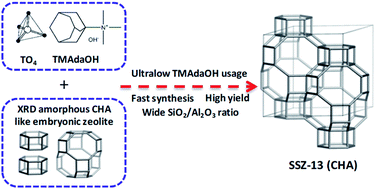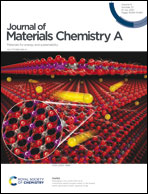Embryonic zeolite-assisted synthesis of SSZ-13 with superior efficiency and their excellent catalytic performance†
Abstract
An X-ray amorphous material with a CHA-like structure, named embryonic CHA zeolite, has been designed and employed for the synthesis of SSZ-13, which leads to ultra-fast crystallization (1.5–12 h), wide product SiO2/Al2O3 ratio (SAR = 22–100) and high yield (82.8–92.9%). The usage of N,N,N-trimethyl-1-adamantammonium hydroxide (TMAdaOH) for the synthesis can be controlled at unprecedentedly low amounts (TMAdaOH/SiO2 = 0.035–0.050). Characterization results reveal that the embryonic zeolite has a small particle size of 10–20 nm, large micro/mesopore volume and abundant double 6-ring units (subunits of the CHA structure). It provides ample active surface and subunits for the formation of the CHA structure and promotes the fast synthesis of SSZ-13 with a wide phase region. The resultant material (SAR = 23.2), after Cu2+ exchange, exhibits superior NH3-SCR activity and extraordinary hydrothermal stability (steaming at 800 °C for 16 h), implying its promising application for NOx removal. In addition, high-silica SSZ-13 shows good catalytic performance for the MTO reaction. It is anticipated that the embryonic zeolite-assisted strategy will benefit the synthesis of more industrially important zeolites.



 Please wait while we load your content...
Please wait while we load your content...